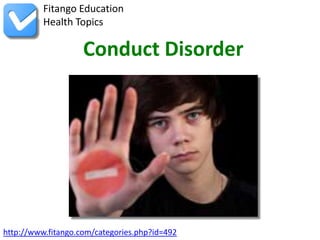
Conduct Disorder
- 2. 1 Overview Conduct disorder is a disorder of childhood and adolescence that involves long-term (chronic) behavior problems, such as: Defiant or impulsive behavior
- 3. 2 Overview Drug use Criminal activity Children with conduct disorder may go on to develop personality disorders as adults, particularly antisocial personality disorder. As their behaviors worsen, these individuals may
- 4. 3 Overview also develop drug and legal problems. Depression and bipolar disorder may develop in adolescence and early adulthood. Suicide and violence toward others are also possible complications of this disorder.
- 5. 4 Symptoms Children with conduct disorder tend to be impulsive, hard to control, and not concerned about the feelings of other people. Symptoms may include:
- 6. 5 Symptoms Breaking rules without obvious reason Cruel or aggressive behavior toward people or animals (for example: bullying, fighting, using dangerous weapons, forcing sexual activity, and stealing)
- 7. 6 Symptoms Failure to attend school (truancy -- beginning before age 13) Heavy drinking and/or heavy illicit drug use Intentionally setting fires Lying to get a favor or avoid things they have to do
- 8. 7 Symptoms Running away Vandalizing or destroying property These children often make no effort to hide their aggressive behaviors. They may have a hard time making real friends.
- 9. 8 Diagnoses There is no real test for diagnosing conduct disorder. The diagnosis is made when a child or adolescent has a history of conduct disorder behaviors. A physical examination and blood tests can
- 10. 9 Diagnoses help rule out medical conditions that are similar to conduct disorder. Rarely, a brain scan may also help rule out other disorders.
- 11. 10 Treatment For treatment to be successful, the child's family needs to be closely involved. Parents can learn techniques to help manage their child's problem behavior. In cases of abuse, the child may need to be
- 12. 11 Treatment removed from the family and placed in a less chaotic home. Treatment with medications or talk therapy may be used for depression and attention-deficit disorder, which commonly occur with conduct disorder. Many "behavioral modification"
- 13. 12 Treatment schools, "wilderness programs," and "boot camps" are sold to parents as solutions for conduct disorder. These programs may use a form of "attack therapy" or "confrontation," which can actually be harmful. There is no research to support these techniques. Research suggests
- 14. 13 Treatment that treating children at home, along with their families, is more effective. If you are considering an inpatient program, be sure to check it out thoroughly. Serious injuries and deaths have occurred with some programs. They are not regulated in many states.
- 15. 14 Causes Conduct disorder has been associated with: Child abuse Drug addiction or alcoholism in the parents Family
- 16. 15 Causes conflicts Genetic defects Poverty The diagnosis is more common among boys. It is hard to know how common the disorder
- 17. 16 Causes is, because many of the qualities needed to make the diagnosis (such as "defiance" and "rule breaking") can be hard to define. For an accurate diagnosis, the behavior must be far more extreme than simple adolescent rebellion or boyish enthusiasm.
- 18. 17 Causes Conduct disorder is often associated with attention-deficit disorder. Both conditions carry a risk for alcohol or other drug addiction. Conduct disorder also can be an early sign of depression
- 19. 18 Causes or bipolar disorder. Children who have severe or frequent symptoms tend to have the poorest outlook. Expectations are also worse for those who have other illnesses, such as mood and drug abuse disorders.
- 20. 19 Prevention The sooner the treatment for conduct disorder is started, the more likely the child will learn adaptive behaviors and prevent some of the potential complications. See your health care provider if
- 21. 20 Prevention your child: Regularly gets in trouble Has mood swings Is bullying others or cruel to animals Is being victimized
- 22. 21 Prevention Seems to be overly aggressive Early treatment may help.